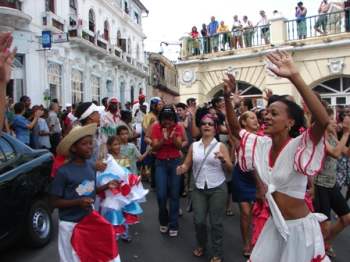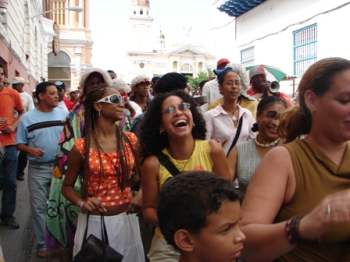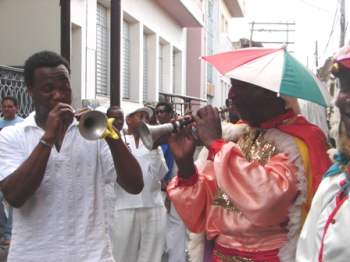Santiago de Cuba on Foot

Guide: Hey, looks like it’s going to rain…
Chorus: All the way to Santiago on foot…
Guide: Getting carried along, you’re going to make it…
Chorus: All the way to Santiago on foot…
The guide: Oh baby, you’re so fine…!
Chorus: All the way to Santiago on foot…
By Dariela Aquique
HAVANA TIMES, July 8 — The above is how the refrain goes to one of most frequently played songs that accompanies Santiagoan conga lines. July has now arrived, the month of parties and merrymaking. That also means that coming up soon is the annual carnival festivities, where people in this blazing hot region will bask in an atmosphere of partying and liveliness.
Some of the main streets have their kiosks adorned with bright showy colors, huge posters and allegorical drawings of the “great bachata,” which are constructed by the enthusiastic residents from this eastern part of the island. Everyone is preparing for this, the greatest celebration of the year.

The central thoroughfare of Garzon Avenue will be the setting for the parades of “paseos y comparsas” made up of enormous lines of dancers and extras executing their choreographies while wearing their masks and their attire decked out with spangles and streamers, all exhibiting amazing designs and competing for awards from the carnival organizers.
The confluences of people from the four corners will show off their imposing totem poles, while the late hours of the night will occupy the makers of the attractive floats. But all this euphoria is nothing compared to the rallying capacity and exaltation caused by any Santiago conga line. In this popular and collective African-originating ritual, people dance to the rhythm of drums and spontaneously file into long snaking lines.

On June 24 (or “San Juan Day”) and June 29 (“San Pedro Day”), these congas appear in the city’s streets. Leading this grand caravan is a throng of partiers who move in circles hoisting an enormous white flag. From far off can be heard the unmistakable sound of the Chinese horn, which is the prelude to the ringing of bells and the beating of drums.
Great multitudes of all the ages and races cram the narrow streets and make the customary journey of each conga through different neighborhoods.
The frantic playing of their percussive instruments, struck with the fingers and palms of the hand, make sure that everyone participates or at least leans out their window, balcony or portico, or that someone might carelessly leave their house unlocked as they give into the temptation to “get carried away” for two or three blocks.

That dance step done while walking, simply and rhythmically, is called arollar (“to get carried away”). The suffocating heat of my native land makes perspiration run down your stomach and below, so taking a shower is required upon returning home from a conga line.
Sweaty, but cheerful, this is how the people of Santiago — at the strike of the requinto and the bocú drums — improvise tunes that allude to life situations or characters on the telenovela being shown at the moment.
Not even in the starkest and most brutal days of the Special Period crisis in the early 90s did people stop coming out. Weary and hungry, they sang and danced their congueros.

Even the Cuban Revolution is indebted to the spirit of the Santiago date (in the midst of carnival, the Moncada garrison was assaulted by the guerilla forces of Fidel and Raul Castro). And also, the most remarkable local martyrs once danced with La Placita, the most popular and often winner of the competitions.
This is the inheritance of the Corpus Cristi (the old religious parades of the first town councils of the island. In these, a one day holiday was given to the slaves and after the processions the owners allowed them to sing and dance with their drums.). That is considered the predecessor of today’s carnivals; it’s a tradition that everyone loves. Our local police officers gather because converging here are the marginal and the discreet, men and women, old people and children.
In the conga lines there are no differences, there’s one sole rhythm but many songs. Like this, for several days every year we all seem equals and happy, everyone responding to the chorus of the refrain by the guide: “All the way to Santiago on foot…”






I like Cuba. There’s a good warm community feeling there. I visited Santiago and the surrounding area back in 2009 and people were very hospitable. They’d sit with you and tell their stories for hours on end. I hope there’ll be better times coming for your country but alas, times are pretty hard everywhere now.